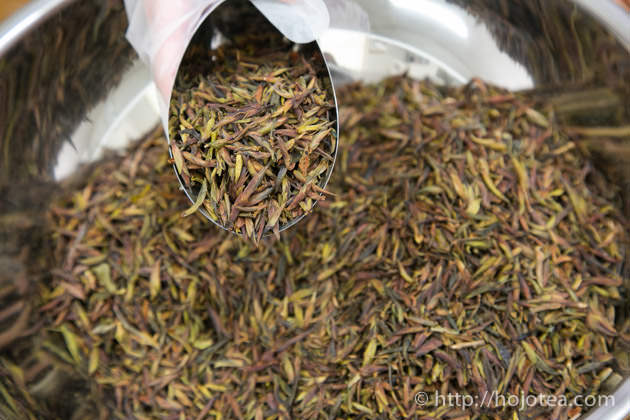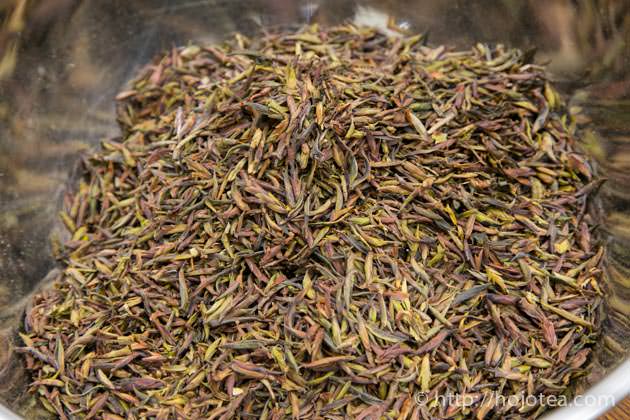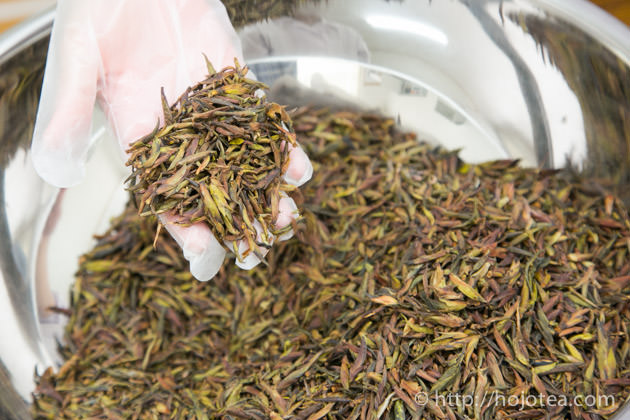- HOME >
- New Arrival at HOJO Online Shop
Wild Spring Bud harvested from the wild tea tree at Da Xue Shan
- [2014.08.22] Posted By Akira Hojo
We just released Wild Spring Bud raw pu-erh mao-cha; it is the loose tea buds harvested from the wild tree at Da Xue Shan area. We had ever sold this tea last year. In last year we only introduced the mao-cha of wild spring bud only for the customer who made a reservation in advance and the balance was compressed into 200g cake.
The native tea collected from the mountain
The Wild Spring Bud is literally the wild tea that is naturally grown in the native forest. It is not referring to the tea tree that age is like 500 years old or 1000 years old. The wild tea means native plant in the forest.
Our wild spring bud is harvested from Da Xue Shan area in Lincang city. The tea processed from the first flush of young buds plucked in March is named as Wild Spring Bud and the tea processed from 1 bud and 2 leaves is named as Da Xue Shan Wild Tea.
Da Xue Shan, Wu Laing Shan and Ai Lao Shan, the major production area of Wild Tea
The wild tea exists not only in Da Xue Shan but also in Wu Liang Shan and Ai Lao Shan, and some are found at the border to Myanmar. As far as I have experienced, generally the wild tea from Wu Liang Shan gives lighter taste in terms of body and after taste and the one from Ai Lao Shan gives the least after taste with slight bitterness. As for the wild tea from Da Xue Shan, it gives strongest after taste and body in general. However, some of the Da Xue Shan wild tea gives bitter taste too. We selected the tea that gives no bitterness.
Camellia Taliensis
In fact, there are many types of wild tea available in Yunnan. The wild tea is not only the tea made from Camellia sinensis but also it consists of a few other sub-species of Camellia sinensis. For example, the Da Xue Shan Wild Tea and Wild Spring Bud are made from the Camellia taliensis, which is said to be the closest species of Camellia sinensis. The Camellia taliensis is often recognized as the wild tea, and also it is found in the tea garden especially near the Myanmar border. I also saw a number of Camellia taliensis planted in the tea garden when I visited Myanmar before. The tea made from Camellia taliensis was traditionally drunk by the minority people.

I saw the tree of Camellia taliensis when I visited the village in Lincang. These tea trees already involve human care and it should not be called as the wild tea.
Clear fruity flavor
The flavour of the Wild Spring Bud is very sweet and clear that reminds us of grapes or green apple. The body of this tea is moderate since it only consists of the spring buds. Instead, it gives a very clear and transparency flavour with lingering sweetish taste on our palate for a long time after drinking.
Related Articles
How to get the latest update on HOJO Tea?
1. Follow Twitter, 2. Click "Like" on Facebook, and 3. Subscribe in newsletter. You can have the latest tea news from HOJO Tea.
 Subscribe the Newsletter to enjoy the privileges
Subscribe the Newsletter to enjoy the privileges- You may receive a free sample upon purchase, or you may have the priority to purchase special products. So please remember to subscribe our newsletter as well as the social network.
- New Release of High Mountain White Tea
- We are pleased to introduce our High Mountain White Tea, sourced from a unique tea garden with two key features: 1. Located at an altitude of 2200-2300m2. Completely wild and untended The ideal natural conditions of this garden result in tea of exceptional quality, offering a pure and gentle, nourishing taste. High Altitude and Wild …
- New Release of Da Xue Shan Wild White Tea 2024
- We have released the 2024 Da Xue Shan Wild White Tea Loose Leaf. This tea was produced under our direct supervision during our stay in Yunnan Province, ensuring meticulous production management on site. Definition of Wild Tea in Yunnan Province People in Yunnan strongly associate Camellia taliensis with wild tea, regardless of where it is …
NEW ARTICLES
 Why Do Some Teas Taste Astringent? Exploring the Causes and Mechanisms of Astringency
Why Do Some Teas Taste Astringent? Exploring the Causes and Mechanisms of Astringency- Tea can range from having no noticeable astringency to possessing a very strong one. What causes this astringency? This article explores the causes and mechanisms behind astringency in tea. Causes of Astringency Astringency arises from the binding of tea components to proteins in the oral cavity, creating a sensation of tightness or dryness. The tongue …
 The Impact of Heat Sources on Tea Flavor
The Impact of Heat Sources on Tea Flavor- It is widely recognized that the material of a kettle plays an important role in shaping the taste of water for brewing tea. Yet, an often overlooked but equally significant factor is the type of heat source used to boil the water. Different heat sources, whether gas, electric, charcoal, or wood fire, can impart distinct …
 New Release of High Mountain White Tea
New Release of High Mountain White Tea- We are pleased to introduce our High Mountain White Tea, sourced from a unique tea garden with two key features: 1. Located at an altitude of 2200-2300m2. Completely wild and untended The ideal natural conditions of this garden result in tea of exceptional quality, offering a pure and gentle, nourishing taste. High Altitude and Wild …
 New Release of Da Xue Shan Wild White Tea 2024
New Release of Da Xue Shan Wild White Tea 2024- We have released the 2024 Da Xue Shan Wild White Tea Loose Leaf. This tea was produced under our direct supervision during our stay in Yunnan Province, ensuring meticulous production management on site. Definition of Wild Tea in Yunnan Province People in Yunnan strongly associate Camellia taliensis with wild tea, regardless of where it is …
 New Release of Wild Pu-erh Jasmine Pearl
New Release of Wild Pu-erh Jasmine Pearl- Out of curiosity, we decided to create a jasmine tea based on Da Xue Shan Wild Raw Tea. This resulted in an exceptionally rare tea, not only in Japan but also in China. Custom Production Network for Jasmine Tea At our store, we source various types of base teas from different regions during the spring. …
 2024 Overview: Our Yunnan White Tea Quality, Process, and Weather Insights
2024 Overview: Our Yunnan White Tea Quality, Process, and Weather Insights- One of the teas we’ve been focusing on in Yunnan Province is white tea. Historically white tea has been produced in both Fujian Province and Yunnan Province for a long time. While white tea from Fujian Province is well-managed during processing, we are dissatisfied with the quality of the raw materials due to the use …
 Yunnan’s Hospitality Culture: Expressed Through Meals
Yunnan’s Hospitality Culture: Expressed Through Meals- In China, as a form of greeting, it’s common to say “你吃饭了吗?” which means “Have you eaten?” However, in Yunnan Province, the phrase “吃饭” is often used in various situations, more like “Eat, eat,” serving as an invitation to share a meal. Yet, with prolonged exposure to Yunnan, one comes to understand that these meal …
 In Search of Wild Tea: Exploring Mountain Villages in Southwest Lincang, Yunnan
In Search of Wild Tea: Exploring Mountain Villages in Southwest Lincang, Yunnan- We are currently sourcing tea in the southwestern part of Lincang City, Yunnan Province. One of the crucial products for us is wild tea. While tea processing is important, securing the raw materials poses the biggest challenge. Recently, we received information about a new location where wild tea supposedly grows. To verify this, we visited …
 New Release of Anxi Traditional Oolong
New Release of Anxi Traditional Oolong- Anxi, located in Fujian province, China, is celebrated for its Tie Guan Yin tea. However, the Traditional Anxi Oolong from this region boasts a unique fruity aroma, distinguishing it from Tie Guan Yin. Anxi: A Renowned Hub for Oolong Tea Production in China Fujian Province, renowned for its rich tea heritage, boasts several prominent tea-producing …
 Yunnan 2024 Spring Tea Sourcing
Yunnan 2024 Spring Tea Sourcing- Yunnan Province is globally renowned for the exceptional quality of its tea leaves. However, lax production management often presents challenges in achieving the desired tea quality when relying solely on pre-made teas. To address this issue, we have committed to remaining on-site throughout the spring season to closely monitor tea production. We are meticulously inspecting …
Shop Info

Address:Lot No. T-215, 3rd Floor, The Gardens Mall, Mid Valley City, Lingkaran Syed Putra, 59200 Kuala Lumpur
Tel: +603-2287-4537
Business Hour: 10am to 10pm
Category
- New Arrival at HOJO Online Shop
- Featured Articles
- Newsletter
- Types of Tea
- Origin of Tea
- Teapot and Tea Equipment
- Tea Column
- How to enjoy tea
- Tea Processing
- How to choose quality tea
- Tea constituents and functional effect
- Safety of Tea
- Foods
- Tea Business Operation
- Hobby and Outdoor Activity
- Ranking of Tea
- Video
- FAQ
- Media Release
Profile

- AKIRA HOJO
- I invite you to experience my tea selections.I was born in Nagano, Japan. In university, I studied agricultural chemistry, and I have the master degree in food science. I worked in Japanese food industry for 10 years. I involved in R&D, QC and QA. As a factory manager, I implemented ISO9000 series and managed the factory.
- The Art of Tea Magazine
- We posted the article on “The Art of Tea Magazine No.9, the magazine is published in Taiwan. We featured some scientific view about the tetsubin
- New Straits Times
- The Malaysian National Newspaper, New Straits Times featured HOJO Tea on 17-Oct-2007.




















